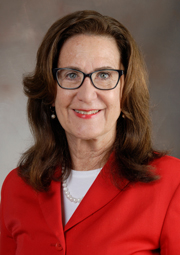
Claire E. Hulsebosch博士
- Professor, Research
Biography
脊髓损伤
脊髓损伤导致的各种变化that continue to be cytotoxic to cells that are at risk of dying, both nerve cells and glial cells-cells that are not nerve cells but are critical for normal spinal cord function. Her group reports that both glial and nerve cells are changed permanently after spinal cord injury. They are in the process of using molecular, behavioral, physiological, immunocytochemical and electrophysiological approaches to study the mechanisms that underlie the permanent changes that will help restore the spinal cord to normal function. Her collaborative manuscripts demonstrate numerous and permanent changes that are many segments above and below the spinal cord injury and persistent changes in neural circuits in these regions that lead to dysfunction. One project is focused on recovery of normal sensory/motor function; another project focuses on improved visceral function, while other projects test the role of transplanted stem cells. For example, her laboratory has demonstrated that molecularly engineered cells transplanted onto the surface of the spinal cord can return the abnormal characteristics of the nerve cells that develop after SCI, to more normal behavior. They hypothesize that persistent neuroinflammation in the spinal cord contributes to permanent alterations in nerve cell circuits, and that the abnormal reaction of microglia and astrocytes after SCI (she calls this “gliopathy”), even many segments away continues to contribute to the neuroinflammation leading to impaired nerve cell function. Insight into these pathways will suggest therapeutic intervention strategies.
目前,Hulsebosch博士是神经系统恢复网络和北美临床试验网络的科学顾问委员会的一部分,它们积极参与脊髓损伤的临床试验。她担任美国国家神经科学倡议卫生研究所的科学顾问,在美国国家神经疾病研究所的研究科,在克雷格·尼尔森基金会(Craig Neilsen Foundation),克里斯托弗(Christopher)和达娜·里夫斯(Dana Reeves)基金会上,新泽西州脊髓损伤研究委员会,新泽西beplay苹果手机能用吗肯塔基州大脑和脊髓损伤研究,纽约脊髓损伤研究委员会以及科学期刊的各种社论和审查委员会。beplay苹果手机能用吗她是2005年至2008年担任Mission Connect的创始人,并且是Baylor,UT Houston和UTMB在成立Mission Connect组成的领导者。
Hulsebosch博士的研究与Missibeplay苹果手机能用吗on Connect的研究如何
Mission Connect is a multi-institutional research group whose mission is to advance research for recovery after brain and spinal cord injury. This is consistent with the more than 300 publications and presentations from her laboratory. She pioneered the concept of nerve cell process reorganization and the formation of new nerve connections (synaptogenesis) in the spinal cord after injury. She has numerous publications that demonstrate the ability of nerve cells to reorganize after spinal cord injury. In addition, she has several publications examining the ability of nerve fibers to reorganize after brain injury and stroke. Three of the interventions described by her laboratory are in clinical trials, or are in use as an off label clinical strategy to improve function after spinal cord injury. The new discovery of chronic neuroinflammation provides a mechanism for continued research to improve function after spinal cord injury. She served as Mission Connect Director from 2005 to 2008 during which time the Moody Center for Brain and Spinal Cord Injury Research/Mission Connect was established at University Of Texas Medical Branch Galveston; University Of Texas Health Science Center/Mission Connect began its recruitment and development; Baylor recruited three nationally renowned neuroscientists that joined Mission Connect, Project Victory for aggressive rehabilitation and community reintegration for our injured troops returning from the Middle East was initiated and Mission Connect was awarded a 33M grant from the Department of Defense to improve function after mild traumatic brain injury.
兴趣范围
beplay苹果手机能用吗研究兴趣
- Acute, subacute and chronic models of spinal cord injury
- 创伤性脑损伤
- chronic inflammation
- neuropathic pain
- 再生和维修
出版物
出版信息
评论
- Hulsebosch,C.E。脊髓损伤后慢性中枢神经性疼痛的机制和治疗策略。最佳。脊髓ind。康复。8:76-91,2003。
- Hulsebosch, C.E. Central sensitization and pain after spinal cord injury. Sem. Pain Med. 1: 159-170, 2003.
选定的出版物
- 神经胶质病可确保脊髓损伤后持续的炎症和慢性疼痛。
- Hulsebosch CE。
- Exp Neurol。2008年11月; 214(1):6-9。doi:10.1016/j.expneurol.2008.07.016。Epub 2008年7月29日。
- Mechanisms of chronic central neuropathic pain after spinal cord injury.
- Hulsebosch CE, Hains BC, Crown ED, Carlton SM.
- Brain Res Rev. 2009年4月; 60(1):202-13。doi:10.1016/j.brainresrev.2008.12.010。Epub 2008年12月25日。
- Remote astrocytic and microglial activation modulates neuronal hyperexcitability and below-level neuropathic pain after spinal injury in rat.
- Gwak YS,Hulsebosch CE。
- 神经科学。2009年7月7日; 161(3):895-903。doi:10.1016/j.neuroscience.2009.03.055。Epub 2009年3月28日。
- P-38Alpha MAPK的激活有助于远离脊髓损伤的尾端区域的神经元过度兴奋性。
- Gwak YS,Unabia GC,Hulsebosch CE。
- Exp Neurol。2009年11月; 220(1):154-61。doi:10.1016/j.expneurol.2009.08.012。Epub 2009年8月20日。
- Peripheral and central sensitization in remote spinal cord regions contribute to central neuropathic pain after spinal cord injury.
- Carlton SM,Du J,Tan Hy,Nesic O,Hargett GL,BOPP AC,Yamani A,Lin Q,Willis WD,Hulsebosch CE。
- 痛。2009 Dec 15;147(1-3):265-76. doi: 10.1016/j.pain.2009.09.030. Epub 2009 Oct 22.
- 大鼠脊髓损伤后,离子型谷氨酸受体有助于维持神经元过度刺激性。
- Leem JW,Kim HK,Hulsebosch CE,Gwak YS。
- Exp Neurol。2010年7月; 224(1):321-4。doi:10.1016/j.expneurol.2010.02.012。Epub 2010 3月6日。
- 脊髓损伤后的GABA和中央神经性疼痛。
- Gwak YS,Hulsebosch CE。
- 神经药理。2011年4月; 60(5):799-808。doi:10.1016/j.neuropharm.2010.12.030。Epub 2011年1月7日。评论。
- 神经元过度兴奋:脊髓损伤后中枢神经性疼痛的底物。
- Gwak YS,Hulsebosch CE。
- Curr Pain HeadacheRep。2011; 15(3):215-22。doi:10.1007/s11916-011-0186-2。审查。
- 脊柱神经胶质细胞的空间和时间激活:神经胶质病在大鼠脊髓损伤后神经性神经病中的作用。
- Gwak YS,Kang J,Unabia GC,Hulsebosch CE。
- Exp Neurol。2012年4月; 234(2):362-72。doi:10.1016/j.expneurol.2011.10.010。Epub 2011年10月21日。
- 小胶质细胞和慢性疼痛的特刊。
- Hulsebosch CE。
- Exp Neurol。2012年4月; 234(2):253-4。doi:10.1016/j.expneurol.2012.01.009。Epub 2012年1月17日。
- Calcium/calmodulin dependent kinase II contributes to persistent central neuropathic pain following spinal cord injury.
- Crown Ed,Gwak YS,Ye Z,Yu Tan H,Johnson KM,Xu GY,McAdoo DJ,Hulsebosch CE。
- 痛。2012 Mar;153(3):710-21. doi: 10.1016/j.pain.2011.12.013. Epub 2012 Jan 31.
- 轻度创伤性脑损伤的啮齿动物模型发展中的挑战。
- Dewitt DS,Perez-Polo R,Hulsebosch CE,Dash PK,Robertson CS。
- J Neurotrauma。2013 May 1;30(9):688-701. doi: 10.1089/neu.2012.2349.
- 活性氧通过在大鼠的脊髓挫伤损伤后通过CAMKII激活CAMKII会导致神经性疼痛和运动功能障碍。
- Gwak YS,Hassler SE,Hulsebosch CE。
- 痛。2013年9月; 154(9):1699-708。doi:10.1016/j.pain.2013.05.018。Epub 2013 5月15日。
- 轻度创伤性脑损伤的研究。
- Robertson CS,Hulsebosch CE。
- J Neurotrauma。2013年5月1日; 30(9):687。doi:10.1089/neu.2013.9939。没有抽象可用。
- 轻度创伤性脑损伤的研究。
- Robertson CS,Hulsebosch CE。
- J Neurotrauma。2013 Apr 15;30(8):609. doi: 10.1089/neu.2013.9940. No abstract available.
- 轻度创伤性脑损伤的啮齿动物模型中的炎症后果。
- Perez-Polo Jr,Rea HC,Johnson KM,Parsley MA,Unabia GC,Xu G,Infante SK,Dewitt DS,Hulsebosch CE。
- J Neurotrauma。2013 May 1;30(9):727-40. doi: 10.1089/neu.2012.2650. Epub 2013 May 6.